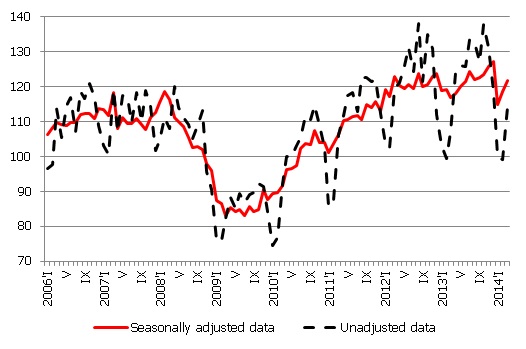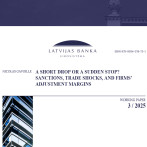Manufacturing output on the rise
According to the Central Statistical Bureau (CSB), manufacturing output in March grew 2.5% month-on-month, seasonally adjusted data. Year-on-year, the manufacturing output in March grew by 3.9% (working day adjusted data). The month-on-month growth in the industry overall was negligible (0.2%), whereas year-on-year data saw a decrease in output (minus 1.6%). This is primarily explained by the plummeting output in the electricity, gas, steam and air conditioning sector due to the warm weather (4.7 degrees above norm).
The month-on-month manufacturing growth in March was supported by the increase in the production of computers, electronic and optical equipment (27.3%), and growth in wood processing. While in 2013 the production of chemicals registered one of the greatest drops in output out of all subsectors (it shrank by 9.5%), the subsector is currently rebounding. In March the growth in the production of chemical substances and products continued for the third consecutive month. After plummeting in January and soaring in February, March again registered a sharp drop in the production of beverages (minus 10.3%). Month-on-month output decreased also in the production of foodstuffs (minus 2.5%), whereas year-on-year, the food industry was growing and continues to be one of the growth engines of manufacturing. The greatest growth year-on-year was observed in the manufacturing of computers, electronic and optical equipment (83.2%) and production of chemical substances (43.2%), as well as in the largest sub-branch – the production of wood and wood products. The output of the non-metallic minerals sub-branch also increased year-on-year. This is in line with the news on the record turnover achieved in the first three months of the year in one of the largest enterprises of the subsector, AS "Valmieras stikla šķiedra".
Evaluating the manufacturing data published in March, we must note that the January drop in manufacturing has been further adjusted and is currently less pronounced than was reported in January and February.
Confidence indicators in industry and Latvia's overall ESI[1] (Economic Sentiment Indicator) posted a rise in April, suggesting that the overall impact on business confidence of the events in Ukraine and Russia last month was not very large. The European Commission’s quarterly business survey also does not point to businesses having a particularly negative outlook on industry development in the second quarter of 2014: 37.4% of manufacturers do not see any factors limiting production, which is the highest level since the survey began in 2004.
As for our trading partners, in April the confidence indicator ESI improved in the European Union, but declined in the euro area. On the other hand, the euro area PMI[2] (Purchasing Manager's Index) continues to point to the fastest growth in the past three years. The manufacturing PMIs in Germany and Poland continue to signal growth in manufacturing output; however, while in Germany growth is even sharper than before, in Poland the index shows a slowing pace of expansion: it has dropped to the level of July 2013. Construction PMIs in Germany and the United Kingdom also continue to point to growth. At the same time, our biggest neighbour is doing worse: the Russian manufacturing PMI in April was under the 50 point mark for the sixth consecutive month.
Illustration. Volume index of manufacturing production (2010=100), seasonally adjusted and unadjusted data

[1] ESI (Economic Sentiment Indicator) is an indicator based on business and consumer surveys published by the European Commission. An indicator above (below) 100 points to a better (worse) moods than the average for recent years.
[2] PMI (Purchasing Manager's Index) is an indicator based on business surveys pointing to the current situation in the economy. A PMI under 50 points to dropping activity and above 50 to increased activity, with 50 pointing to a neutral situation.
Textual error
«… …»






